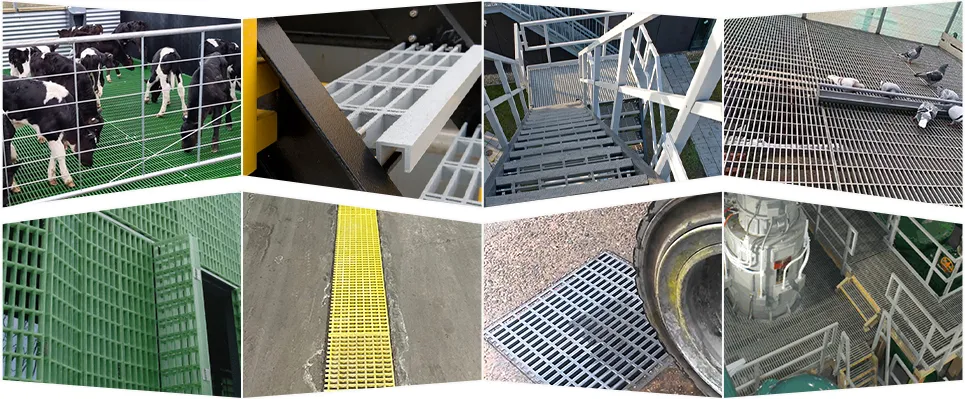loading...
- No. 9, Xingyuan South Street, Dongwaihuan Road, Zaoqiang County, Hengshui, Hebei, China
- admin@zjcomposites.com
- +86 15097380338
- Welcome to visit our website!
Exploring 38mm GRP Grating Applications and Benefits in Industrial Projects and Construction Solutions
Understanding 38mm GRP Grating An Overview
GRP (Glass Reinforced Plastic) grating has become increasingly popular in various industries due to its unique properties and advantages. Among the different specifications available, 38mm GRP grating stands out for its versatility and robustness. This article aims to provide a comprehensive understanding of 38mm GRP grating, its applications, benefits, and considerations for potential users.
What is GRP Grating?
Glass Reinforced Plastic grating is a composite material made from a combination of glass fibers and a polymer resin. This combination results in a lightweight yet strong grating material that can withstand harsh environments. The manufacturing process involves pultrusion, where the glass fibers are pulled through a resin bath and then cured, leading to a consistent product with predictable performance characteristics.
Key Features of 38mm GRP Grating
1. Dimensions and Load Capacity The 38mm designation refers to the depth of the grating, which is an important factor in determining its load-bearing capabilities. This depth allows for significant strength while maintaining a low weight compared to traditional metal grating. Depending on the specific configuration and application, 38mm GRP grating can handle a variety of loads, making it suitable for different industrial requirements.
2. Corrosion Resistance One of the most significant advantages of GRP grating is its inherent resistance to corrosion. Unlike steel grating, which can rust and degrade over time when exposed to moisture and chemicals, 38mm GRP grating remains unaffected. This property makes it ideal for use in chemical processing plants, wastewater treatment facilities, and coastal environments where salt corrosion is a concern.
3. Safety Features GRP grating often comes with anti-slip surfaces, which enhance safety in environments where slip hazards exist. This feature is particularly valuable in industrial settings, where workers may be exposed to wet or slippery conditions. The visibility provided by colored grating can also aid in safety by marking pathways and preventing accidents.
38mm grp grating

4. Lightweight and Easy Installation 38mm GRP grating is considerably lighter than steel alternatives, facilitating easier handling and installation. This lightweight characteristic can lead to savings on transportation costs and labor. The installation process is often simplified due to the grating's modular components that can be cut and fitted to meet specific requirements.
Applications of 38mm GRP Grating
The applications of 38mm GRP grating are extensive. In the construction industry, it is commonly used for walkways, platforms, and stair treads where safety and slip resistance are paramount. In the chemical sector, its corrosion-resistant properties make it essential for flooring and support structures within plants. Furthermore, waste management facilities use GRP grating for its durability and low maintenance requirements.
Considerations When Choosing GRP Grating
While 38mm GRP grating has numerous benefits, there are certain considerations potential users should keep in mind. The initial cost may be higher than traditional materials, but this should be viewed in the context of long-term savings due to durability and low maintenance needs. Furthermore, it is essential to ensure that the grating is appropriately rated for the specific application to achieve optimal performance.
Conclusion
In summary, 38mm GRP grating is a robust and reliable option for various industrial applications. Its lightweight nature, corrosion resistance, and safety features make it an excellent alternative to traditional materials. As industries continue to seek innovative solutions, GRP grating represents a significant advancement in terms of material technology, ensuring that functional and safety needs are met without compromising on performance. As with any material, it is crucial to assess the specific requirements of your project to determine the best fit, ensuring a successful installation that meets both performance and safety standards.
-
GRP Structures: The Future of Lightweight, High-Performance EngineeringNewsJun.20,2025
-
FRP Water Tank: High-Performance Storage for Corrosive and Clean Water SystemsNewsJun.20,2025
-
FRP Square Tube: The New Industry Standard for Chemical and Structural ApplicationsNewsJun.20,2025
-
FRP Pultruded Profiles: The Ultimate Choice for Lightweight Structural StrengthNewsJun.20,2025
-
FRP Handrails: The Safer, Smarter, and Stronger Choice for Modern InfrastructureNewsJun.20,2025
-
FRP Grating: The Smart Solution for Durable, Lightweight Industrial FlooringNewsJun.20,2025
-
Why Choose a Galvanized Water Tank for Your Storage NeedsNewsMay.21,2025
